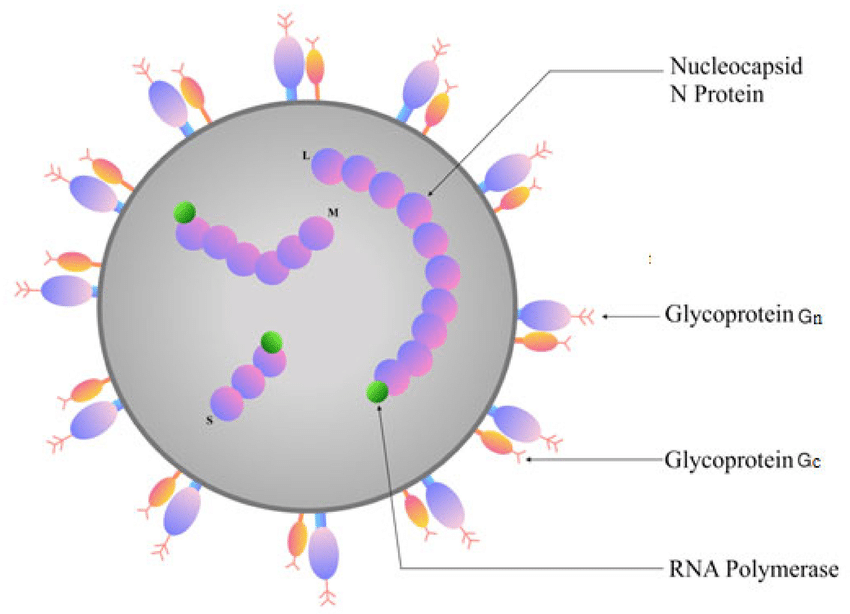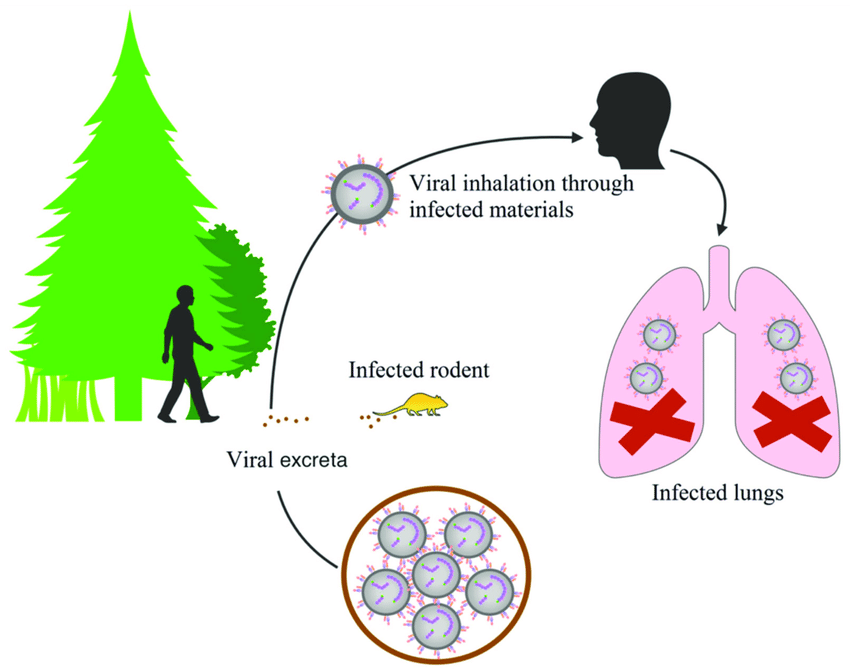A rare but dangerous illness know as hantavirus pulmonary syndrome (HPS) or hemorrhagic fever with renal syndrome (HFRS) can be brought on by the hantavirus family of viruses. Hantaviruses are transmitted to human beings by infected rodents such as deer mice, cotton rats, and rice rats through their urine, feces and saliva.
Classification of Hantavirus
Hantaviruses are classified into the family Hantaviridae, which is further divided into two genera: Orthohantavirus and Thottimvirus.
Orthohantaviruses, commonly referred to as “Old World” hantaviruses, are common in Europe and Asia and have been associated to hemorrhagic fever with renal syndrome (HFRS). They are transmitted to human beings by infected rodents, including as rats and mice, through their saliva, feces, and urine.
Thottimvirus, also known as “New World” hantaviruses, are found in the Americas and are associated with hantavirus pulmonary syndrome (HPS). They are transmitted to human beings via the urine, feces, and saliva of infected rodents including cotton rats and deer mice.
There are several different species of hantaviruses within each genus, each of which is associated with different rodent species and geographic regions. Some of the most common hantaviruses associated with human disease include:
- Hantaan virus: Found in Asia and the causative agent of HFRS
- Dobrava-Belgrade virus: Found in Europe and the causative agent of HFRS
- Sin Nombre virus: Found in North America and the causative agent of HPS
- Andes virus: Found in South America and the causative agent of HPS
Understanding the epidemiology and clinical presentation of hantavirus infections depends on the classification of hantaviruses. different rodent hosts, clinical presentation, and geographical regions are associated with different hantavirus species, which may help guide preventative and treatment strategies.
Structure of Hantavirus
- Hantaviruses are enveloped viruses, which means their genetic material is enclosed in an outer lipid membrane. A segmented single-stranded RNA molecule makes up the viral genome.
- With a diameter of around 80–120 nanometers, the virus particle has a roughly spherical shape. The outer coat of the virus particle is covered in glycoproteins that stick out from its surface and give it a spikey appearance.
- The virus’s surface glycoproteins are essential for allowing the virus to enter host cells. These proteins bind to certain receptors on the outside of host cells, triggering off a series of events that allows the entry and replication of the virus.
- The RNA genome is tightly packed with nucleocapsid proteins inside the viral envelope to create a helical ribonucleoprotein (RNP) complex. The matrix layer, an inner protein layer that surrounds the RNP and helps in maintaining the virus particle’s form, is present inside the RNP.

Overall, the structure of hantaviruses is similar to other enveloped RNA viruses, such as influenza virus and HIV. However, the specific arrangement of the viral genome in segments and the presence of the helical RNP complex are unique features of hantaviruses.
Geographical Distribution of Hantavirus
With the exception of Australia and Antarctica, hantaviruses are present across the world. The incidence of hantavirus infection and specific hantavirus types varies by geographical location.
The Sin Nombre virus (SNV) and the Andes virus (ANDV) are the two most common hantaviruses in the Americas. Hantavirus pulmonary syndrome (HPS) and hantavirus cardiopulmonary syndrome (HCPS) are caused by these viruses, which are mostly found in North and South America.
Different hantaviruses are common all through Asia, Africa, and Europe. For example, the Hantaan virus (HTNV) and the Seoul virus (SEOV) are found in Asia and are responsible for hemorrhagic fever with renal syndrome (HFRS). A small form of HFRS called nephropathia epidemica is caused by the puumala virus (PUUV), which is common in Europe.
The distribution of hantaviruses is closely linked to the presence of their rodent hosts. Each hantavirus has a particular species or group of rodent animals as its hosts, and the location of these rodents determines the virus’s global spread. For example, in North America, the deer mouse serves as the main host for SNV, but in South America, the Andean pygmy rice rat serves as the main host for ANDV.
Lifecycle of Hantavirus
The lifecycle of hantavirus involves two primary hosts: a rodent host and a human host. The virus is primarily transmitted to humans through exposure to the feces, urine, or saliva of infected rodents. Here are the basic steps of the hantavirus lifecycle:
- Rodent host: The virus infects the rodent host through direct contact with the virus or through inhalation of airborne particles contaminated with the virus. The virus can persist in the rodent’s body without causing significant illness.
- Virus shedding: Infected rodents shed the virus in their urine, feces, and saliva, which can contaminate the environment and potentially infect humans who come into contact with the contaminated materials.
- Human infection: Humans can become infected with hantavirus through direct contact with infected rodents or their secretions, inhalation of contaminated airborne particles, or consumption of contaminated food or water.
- Virus replication: Once the virus enters a human host, it replicates in various organs and tissues, including the lungs, kidneys, and blood vessels.
- Symptoms: After a period of incubation, symptoms of hantavirus infection may appear, including fever, fatigue, muscle aches, and respiratory distress.

Diagnosis of Hantavirus infection
Hantavirus infection is diagnosed based on clinical symptoms that are confirmed by laboratory investigations. It is important to contact a doctor if we believe we have been exposed to the hantavirus or are having symptoms because these illnesses’ symptoms might be similar to those of the flu and other respiratory infections.
Blood testing, PCR tests, and serology tests are all diagnostic procedures for hantavirus infection. Hantavirus-specific antibodies can be found by blood testing, and viral RNA can be found through PCR assays in tissue or blood samples. In serology testing, antibodies to the hantavirus are examined for in the blood.
A complete medical history and physical examination may help in the diagnosis of hantavirus infection in addition to laboratory investigations. A medical professional will inquire about recent travel, contact with mice or locations with rodent infestations, and other circumstances that might point to hantavirus infection.
If we believe we have been exposed to the hantavirus or are exhibiting symptoms, it is important to get healthcare right once since the infection can spread quickly and cause serious illness or even death. Early treatment start provides the best results, and rapid diagnosis may reduce problems and improve outcomes.
Symptoms of Hantavirus infection
Symptoms of hantavirus infection can vary depending on the specific virus and the severity of the disease. However, common symptoms of hantavirus infection can include:
- Fever
- Headache
- Muscle aches
- Fatigue
- Dizziness
- Chills
- Nausea and vomiting
- Abdominal pain
- Shortness of breath
- Dry cough
In severe cases of hantavirus infection, symptoms can progress to include:
- Rapid breathing
- Low blood pressure
- Respiratory failure
- Kidney failure
- Bleeding disorders
If we suffer any of these symptoms after having been infected with hantaviruses, we should consult a doctor very once, especially if we live or work in an area where rodents are abundant. Early diagnosis and treatment may reduce complications and improve outcomes.
Preventive Measures
Preventing hantavirus infection involves reducing the risk of exposure to infected rodents and their droppings. Here are some prevention strategies:
- Keeping our living and working spaces clean. Surfaces that could be contaminated with rodent feces, urine, or saliva need to be disinfected and cleaned often.
- Seal up holes and cracks since rodents may slip through tiny spaces. To keep rats out of our house or place of business, seal up any cracks or holes.
- Store food properly: Do not leave food out in the open and always keep it in sealed containers. This reduces the chance of attracting rats to our home or place of business.
- Use traps and baits: Use traps or baits to control rodent populations. Be sure to follow instructions carefully and place them in areas where rodents are likely to frequent.
- Wear safety equipment: To avoid contracting the virus when cleaning locations where rats may have resided, put on gloves, a mask, and protective clothes.
- Control rodent populations: Work with a pest control professional to control rodent populations in your living or work area.
- Be aware of high-risk areas: Be aware of areas where hantavirus is more common, such as rural areas or areas with heavy rodent infestations.
By taking these preventative measures, we can reduce our risk of exposure to hantavirus and other rodent-borne illnesses.
Treatment
Hantavirus infection is not treated or cured in any particular way. The risk of problems can be decreased and results can be improved with immediate medical attention.
- Hospitalization: Hospitalization for supportive treatment, such as fluids, oxygen, and mechanical breathing, may be necessary in severe cases of hantavirus infection.
- Antiviral drugs: Antiviral drugs may occasionally be used to treat hantavirus infection. These drugs work best, though, when they are given early in the course of the illness.
- Symptomatic treatment: Using the right drugs to treat symptoms like fever, pain, and respiratory distress can help patients feel more comfortable and help avoid problems.
- Prevention of complications: Preventing complications like kidney and lung failure is an essential component of treatment. This could involve monitoring the kidneys’ function, controlling fluid balance, and protecting against pneumonia.
When we experience symptoms or believe we may have been exposed to the hantavirus, it’s important to seek medical care right away. Early diagnosis and treatment can enhance outcomes and reduce problems. Additionally, avoiding contact with rodents and their waste can help reduce the possibility of exposure to the hantavirus, which can help prevent illness.